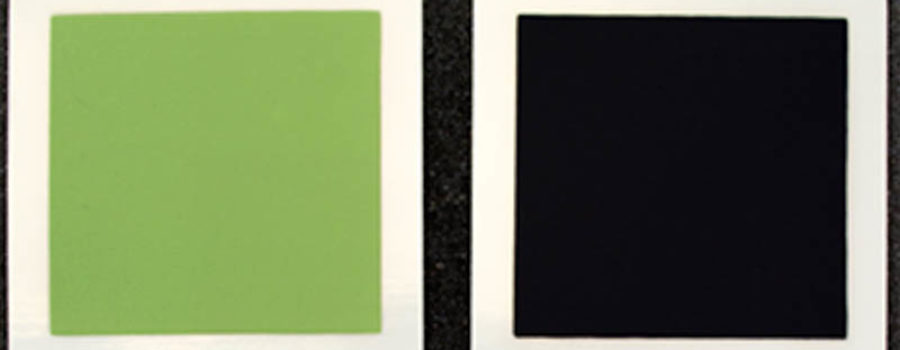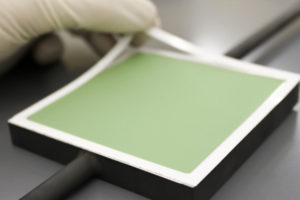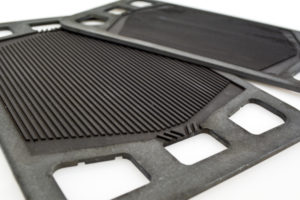Nexceris introduced the NextCell™ component in 2007, in response to the needs of cell and materials researchers. Utilizing a high-performance Hionic™ electrolyte support, the NextCell™ provides a unique value in the market providing a well-characterized and reproducible performance characteristic combined with excellent mechanical strength and an easy-to-seal perimeter.
The architecture of the NextCell™is shown in Figure 1. The dense Hionic™ electrolyte provides a structural backbone to the device and creates a dense surface for sealing on the anode or cathode side of the cell. The electrodes consist of a multi-layered LSM-GDC/LSM cathode and a multi-layered NiO-GDC/NiO-YSZ anode. Both electrodes have 50 µm nominal thicknesses.
Performance of the NextCell™ is shown in Figure 2. At 800 °C, the fuel utilization reaches a maximum of 47 percent at 0.7 volts, generating approximately 0.38 W/cm™ with an area specific resistance of 0.65 Ω-cm² between 0.7 and 0.9 V. This performance is consistent with the design and construction of the cell.
The NextCell™ has found application in evaluations of electrode performance (references) and poisoning (references) studies in laboratories world-wide. Designed with a well-known LSM cathode and a NiO-YSZ electrode, the cell performs well at operating temperatures from 750 °C and up. However, as time has passed, the average operating temperatures for SOFCs has declined to a temperature range of 700 °C, with the adoption of higher-performing LSCF cathodes. Given the more challenging kinetics of operation in this temperature range, we determined a more electrochemically active NextCell™ was needed to assist researchers working in these systems.
The NextCell-HP™ has been developed to provide researchers with a higher-performing cell more suitable for use at lower operating temperatures. Figure 3 shows the architecture of the NextCell-HP™. The cathode formulation has changed from LSM-based to LSCF based to provide higher performance. The GDC interfacial electrolyte/electrode layer has been replaced with a SDC based barrier layer.
Taking advantage of many years’ experience developing protective coatings through controlled layer deposition Nexceris has implemented improved manufacturing processes to provide a higher performing cell at a lower price point than the traditional NextCell™. Instead of screen-printing, electrodes are constructed on the same Hionic™ electrolyte through Aerosol-Spray Deposition (ASD), a deposition process that enables fine-control deposition of electrode layers and is readily amenable to low-cost manufacturing. Improved control has enabled thinner electrode thicknesses (nominal thickness for both anode/cathode 30 µm). The improved electrode uniformity achieved with the ASD compared to screen-printing is illustrated in the microstructural comparison of NextCell™ vs.NextCell-HP™ in Figure 4.
Nexceris’ coating facility for NextCell-HP™ manufacture is shown in Figure 5. The facility is equipped with two PRISM 300 spray (Ultrasonic Systems, Inc.). These spray-systems utilize USI’s nozzle-less ultrasonic spray-head technology to enable highly controlled deposition with very high transfer efficiency, ideal features for cost-effective electrode fabrication.
Figure 6 shows a performance comparison of the Nextcell™ versus the NextCell-HP™ at 800 C. The improved microstructure control and LSCF based cathode provide the NextCell-HP™ with improved performance.

Figure 5. Nexceris’ coating facility for NextCell-HP™ manufacturing
Figure 7 shows cross-section micrographs of the NextCell-HP™ superimposed with EDS compositional maps to illustrate the multi-layered anode and cathode electrodes.

Figure 7. Cross-section micrographs of the NextCell-HP™ superimposed with EDS compositional maps.
A key advantage of the NextCell-HP™ is the improved uniformity that the ASD process provides relative to screen-printing, both within cell (Figure 4) and cell-to-cell. For researchers that use the NextCell™ platform to perform comparative experiments it is very important that there is minimal cell-to-cell variation. Figure 8 demonstrates the improved cell-to-cell electrode variability for the NextCell-HP™.












